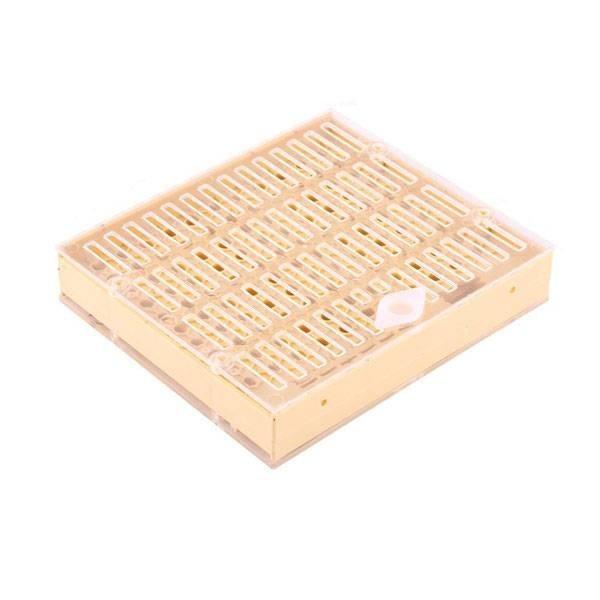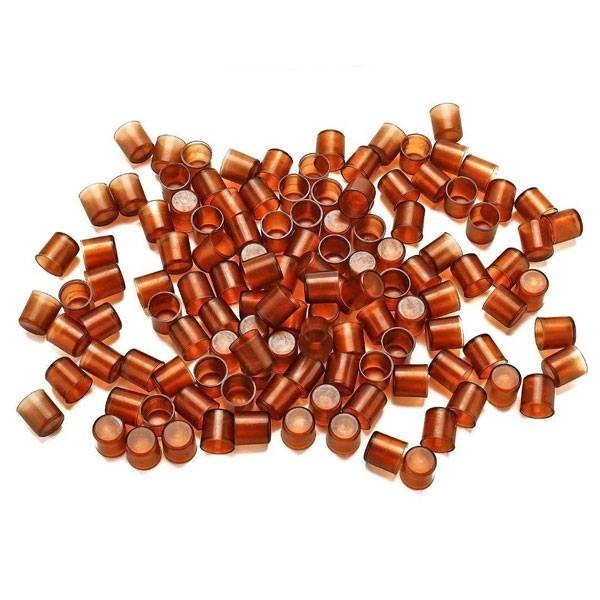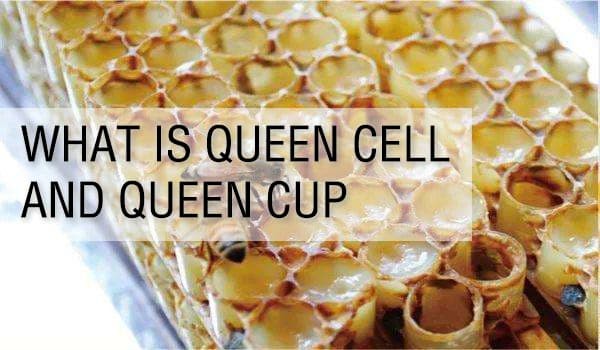Honeybees are essential for pollination and play a vital role in the agricultural industry. The European honeybee is the most common species of honeybee in the world and queen cups are a common sight in their hives. Queen cups are used to rear new queens and can be a good or bad thing depending on the beekeeper's needs. If a hive is queenless, then the presence of queen cups is a good sign that the bees are trying to create a new queen. However, if the hive already has a queen, the queen cups can be a sign that the bees are preparing to swarm. Swarming is when a portion of the bees leave the hive to form a new colony. This can be problematic for the beekeeper if they are not prepared for it.
Although bees can theoretically keep their colony going forever, it doesn't always work out that way in practice. There are a number of reasons why a colony might not make it, including disease, pests, bad weather, and lack of food. Even if a colony does manage to survive, it is likely that the bees will eventually die off anyway, due to old age or simply because they are not replaced when they die.
The three most common reasons for a hive to make its own queen are swarming, supersedure, and absconding. A swarm is when the bees feel like their hive is getting too crowded and they will split off and find a new place to live. The old queen will take half the bees with her and the remaining bees will make a new queen. A supersedure is when the bees feel like their queen is getting old or is not performing well. The bees will make a new queen to take her place. An absconding is when the bees feel like their hive is in danger. They will leave their hive and find a new place to live.
three most common reasons
The colony has gone completely queenless
The previous queen is injured or otherwise unable to do lay eggs at a high level and maintain who role
The colony is wanting to divide into several different colonies and needs new queens for the new colonies
Queen cups are a normal part of a beehive and typically nothing to worry about. They are often found during the spring and summer months and serve as a place for the queen to lay her eggs. If you do find queen cups in your hive, simply check to make sure that there is an egg inside and then leave them be.
Honeybee colonies will occasionally produce a queen cup, which is a special cell that is larger than a regular bee cell. This is usually done when the colony feels like it is time to raise a new queen. The old queen will then leave the hive with a group of bees (called a swarm), and the new queen will stay behind and take over the hive. The queen cup is simply insurance in case something happens to the old queen.
Building a queen cup is the equivalent of pouring a concrete foundation for a home that you may or may not build later. It's a way of preparing for something that may never happen, but if it does, you'll be glad you took the time to do it right.
If a bee colony needs a new queen, the bees can create a queen cup. This is a special cup that is used to house a new egg that will become the queen. The bees will add fresh comb to the queen cup to make sure that the new queen has everything she needs to thrive.
Queen Cell
The main difference between a queen cell and a queen cup is the size. A queen cell is much larger and looks like a small cone. These are often found on the sides of frames or in the corners of beehives.
Queen Cup
A queen cup is a small little cup that is often on the bottom of the frame built from the comb and directly on the comb. The cup is used to help protect the queen bee as well as to serve as a place for eggs to be laid. The bottom of the cup is slightly concave to help the eggs stay in place and not roll off.
When bees need to make a new queen, they will build several queen cups. These are special cups that are just the right size for a queen bee. The bees will fill the queen cups with royal jelly, which is a special food for queen bees. The bees will then wait to see which queen cup hatches first. The first queen to hatch will become the new queen.
When Do Bees Build Queen Cups?
Even though the bees will build 10-15+ in a single hive of these cups, they are rarely being used. The main use for them is to store excess honey in the hive, and to be used as an emergency food source for the bees.
Consequently, frames containing queen cups and cells should be reserved for spring build-up or moved to those areas.Queen cups and cells are made from beeswax, which bees are not able to produce during the fall and winter months, with the exception of in sub-tropical and tropical areas. Thus, frames containing queen cups and cells should be set aside for use during spring build-up, or moved to be stored in those areas where the temperature allows for year-round wax production.
Queen cups are built most often in the spring because this is when bees are most likely to swarm. When a beehive swarms, the old queen leaves with a group of bees to start a new colony elsewhere. This leaves the original hive without a queen, so the worker bees build a new one.
What Do I Do If I Find Queen Cups?
If you find a queen cups in your hive, there is no need to be alarmed. This is simply the queen's way of preparing for the possibility of having to produce a new queen. The queen cup is a small cup-like structure that the queen will lay an egg in. If the hive becomes queenless, one of the eggs in a queen cup will be fertilized and will develop into a new queen.
When we see queen cups during the spring or summer, we simply tilt the frame up and look up into the cup. It takes a sharp eye to see an egg, but that is what we are looking for. The queen will lay her eggs in these cups, and the Beekeeper will then move the frames containing these cups into the brood chamber.
If you look inside the queen cup and don't see anything, there isn't anything you need to do. The queen cup is a small, round, white cup that is placed under the queen bee during transportation. It is there to protect her and keep her from getting hurt.
If you see an egg or larva in your beehive, it means the bees are creating a new queen. The old queen will typically leave the hive with a large group of bees, known as a swarm, in search of a new place to build their home. This process is known as swarming and usually happens in the spring.
In just over two weeks, that queen cup will have developed into a queen cell and be much bigger. It takes 16 days from the day the egg is laid to the time the queen hatches out.
If you see signs that a beehive is making a new queen, it's possible that the existing queen is about to die or that the hive is preparing to swarm. Swarming is when a large group of bees leaves the hive in search of a new home. It typically happens in the spring, but it can happen at other times of the year if the hive is overcrowded.
There are a few ways to tell if a queen cup is old or new. One way is to look at the color. Old queen cups are usually dark brown, while new queen cups are lighter in color. Another way to tell is by the size. Old queen cups are usually smaller than new queen cups. Finally, you can tell by the shape. Old queen cups are usually more round, while new queen cups are more oval.A queen cup is a special cell in a honeybee colony that is used to rear a new queen. The old queen lays an egg in a queen cup, and the workers feed and nurture the larva until it hatches and emerges as an adult queen.
Old queen cups will have rounded edges, while new queen cups will not. This is because the old queen cups have been used before and the new ones have not. The new queen cups will have sharper edges because they have not been used.
The main thing is to not let them get too dry, as this will make them more difficult to work with. A new queen cup will be soft, fragile, and very nicely formed with crisp edges. Because they are so delicate, it is easy to damage them, but this is ok if you do damage them. The main thing is to not let them get too dry, as this will make them more difficult to work with.
Queen cells are a bigger deal than queen cups and can’t be taken as casually as a queen cup. If you spot a queen cell, it means that the bees in your hive are preparing to swarm. This is a serious issue because it means that half of the bees in your hive will leave, taking their pollen and honey with them. To prevent your hive from swarming, you need to remove the queen cell and replace it with a queen cup.
When bees make queen cells, it is a major event for the colony and marks a period of high risk for its success. The colony has to make sure there is enough food for the developing queen and her court, and that the old queen is healthy enough to lay the eggs. If the old queen is not able to lay eggs, the colony will perish.
If a queen is getting old, her abdomen will start to look elongated and thin. The bees will also start to build queen cells, which are larger than normal cells and have a peanut-like shape. If you see these signs, it's time to replace the queen.If you're keeping an eye on a colony of bees in order to spot when they're making a new queen, you should also be on the lookout for signs that the previous queen is getting old. An old queen's abdomen will start to look elongated and thin, and the bees will also begin to build queen cells, which are larger than normal cells and have a peanut-like shape. If you see these signs, it means it's time to replace the queen.
The previous queen was a victim of their own success because they looked good and were laying a lot of eggs.
When a colony is doing really well in the spring, it is likely they will have multiple queens and will produce queen cells. This is because the colony is doing well and has a lot of resources. The queen cells are produced in order to create new colonies.
When a colony of bees begins to produce queen cells, it is a sign that the old queen is getting ready to leave. The old queen will take half of the bees with her to start a new colony elsewhere. The queen cells that are left behind will hatch and the new queens will take over the responsibilities of the old queen.
If you only see one or two queen cells, they are likely just replacing the previous queen with a new one and not swarming. This is because if the bees are preparing to swarm, they will build many queen cells in order to have a new queen for the new hive.
A new queen bee is a good thing as it shows that the previous queen wasn't capable of fulfilling her responsibilities. The bees will sort it out and you don't need to do anything. Just close up the hive and don't open it for 2-3 weeks.
Nicot Queen Rearing Cassette Wholesale
This Nicot Queen Rearing Cassette is an essential part of the Nicot queen rearing method. It confines the queen to the cassette and only allows her to lay eggs in the brown cell cups (sold separately) inside.

Nicot Brown Queen Bee Cup Wholesale
These queen bee cup are a part of queen rearing using the Nicot method. They are made to be installed in a queen rearing cassette, where the queen will lay eggs into them.


